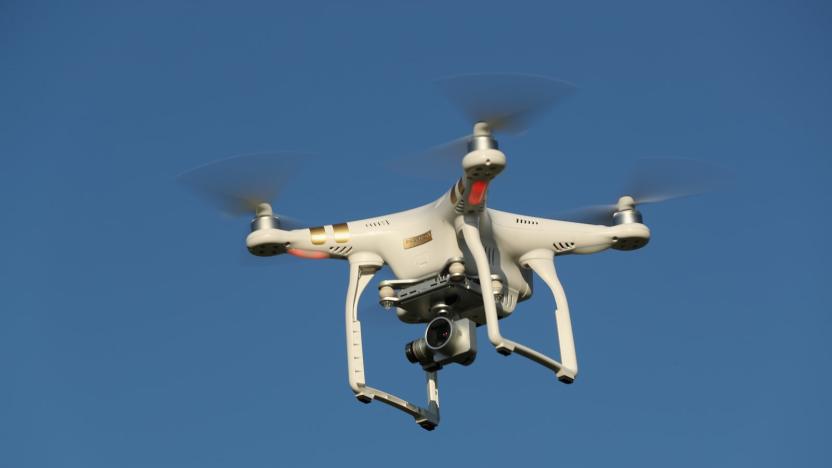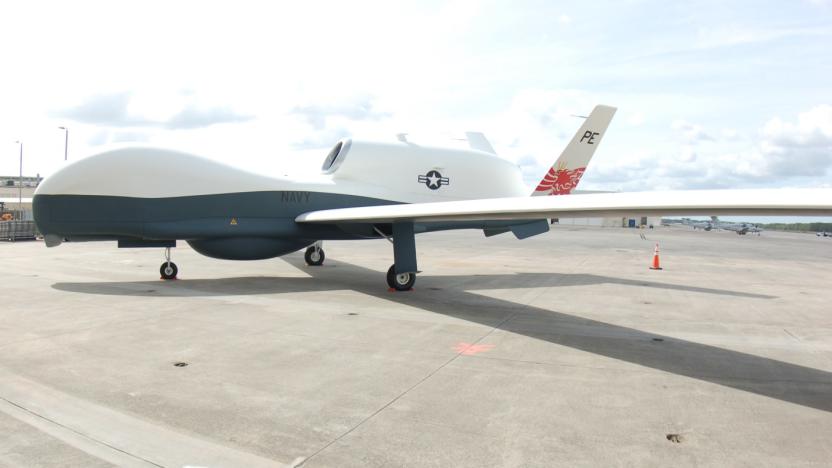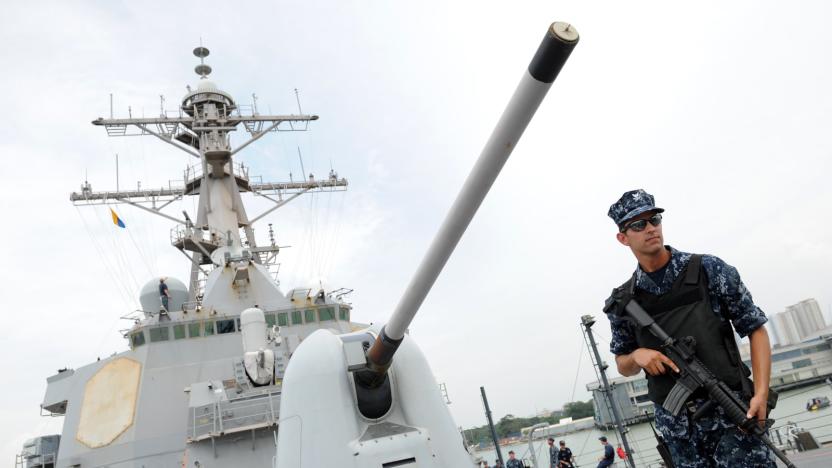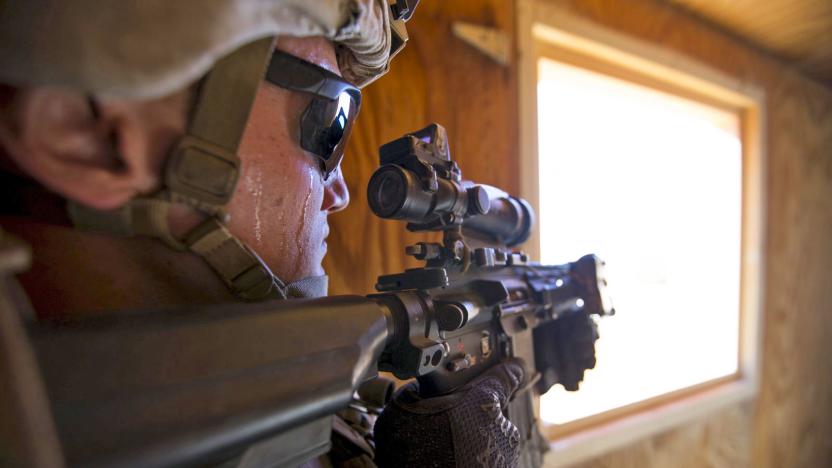usnavy
Latest

Chinese hackers reportedly hit Navy contractors with multiple attacks
Chinese hackers have been targeting US Navy contractors, and were reportedly successful on several occasions over the last 18 months. The infiltrators stole information including missile plans and ship maintenance data, according to a Wall Street Journal report that cites officials and security experts.

After Math: The best kind of falling star
Gavin McInnes and his gang of Proud Boys, newly minted stars of the Alt-Right, took their first steps back toward irrelevancy this week when they got themselves banned from Facebook. At the same time, we've had to say goodbye to a pair of space-based telescopes (Kepler and Dawn), as they reached the end of their operational lifespans; Roscosmos blamed the recent Soyuz launch failure on a bent sensor pin and Apple announced that it would no longer report the sales numbers for the stars of its product lineup -- iPhones, iPads and Macs -- after it was reported that smartphone sales slumped six percent globally this year.

Navy backs 'omniphobic' coatings to help ships travel farther
Researchers have already explored the idea of using water-repellent ship coatings that let ships travel faster and farther. The US Navy, however, is taking things a step further. It's backing University of Michigan work on an "omniphobic" coating that shrugs off virtually any liquid (it'll even fend off peanut butter) while lasting for a long time. Ships could theoretically glide through the water without nearly as much friction as ordinary vessels, consuming less fuel and traveling longer.

Synthetic 'blubber' could triple divers' survival time in icy water
Even the hardiest diver can't last longer than an hour in cold water using a modern wetsuit, and that's no good if you're a special ops soldier or otherwise need to stay under the sea for hours at a time. MIT has a simple solution: imitate the blubber that keeps seals and polar bears safe. They've developed an "artificial blubber" that promises to extend swim times in chilly water (under 50F) to as long as three hours. The approach combines a newly processed material with pockets that keep the cold out.

Chinese hackers stole undersea warfare data from US Navy contractor
Hackers associated with the Chinese government have broken into a US Navy contractor's systems and stolen data about undersea warfare. According to The Washington Post, these include secret plans to create a new anti-ship missile usable on US submarines by 2020.

Autonomous helicopter completes Marine resupply simulation
Drones have become a part of the modern battlefield, but what about autonomous full-size aircraft? Aurora Flight Sciences just successfully demonstrated its self-flying setup, the Autonomous Aerial Cargo Utility System (AACUS), enabling an older helicopter to fly itself at soldiers' requests. In the future, troops in the field could use this tech to order autonomous supply deliveries with nothing more complicated than a tablet.

US Army reportedly ceasing use of all DJI drone products
According to a memo obtained by sUAS News, the US Army will stop using DJI drones, effective immediately. "Due to increased awareness of cyber vulnerabilities associated with DJI products, it is directed that the US Army halt use of all DJI products," said the memo, which listed flight computers, cameras, radios, batteries, speed controllers, GPS units, handheld control stations and any device with DJI software applications installed on it as products that must cease being used. According to the document, the Army Aviation Engineering Directorate has issued over 300 Airworthiness Releases for DJI products. "Cease all use, uninstall all DJI applications, remove all batteries/storage media from devices, and secure equipment for follow on direction," the memo continued.

Watch the US Navy’s electromagnetic catapult launch a fighter jet
The US Navy's next-gen Electromagnetic Aircraft Launch System (EMALS) has already shown it can hurl weighty dead-loads. Now, after months of trials, it just propelled its first actual aircraft. A jet fighter performed the first EMALS launch and recovery from the USS Gerald R. Ford on Friday.

The Navy’s railguns are ready for live-fire field tests
The US Navy has been testing its railguns, which fire shells at high velocity using electromagnets instead of explosive propellant, for years. Test footage emerged in 2012 showing off successful demonstration of the experimental weapon on land targets. But at long last, the military's new artillery piece is ready for live-fire testing in the field.

Robots could soon cooperate on surveillance
Computers are getting better at spotting objects, but they tend to work in isolation. What good would a security robot be if it couldn't share info about an intruder with other machines? Cornell scientists might have an answer. They're designing a system that would let robots and other autonomous devices cooperate with each other on identifying and tracking objects. Each bot would send its imagery to a central unit that could talk to both other camera systems and the internet to help identify objects. The group would combine and compare images to follow objects and collect more information about them, getting more data than they would if they did all the work by themselves.

US Navy's MQ-4C Triton drone prepares for deployment in 2018
The last time we mentioned the Navy's long-range MQ-4C Triton drone was in 2013, and the project is still creeping towards eventual deployment. Northrop Grumman announced this week that it has completed formal lab testing, and also successfully flew for the first time with a software upgrade adding "Traffic Alert and Collision Avoidance System (TCAS), multi-aircraft control and additional Multi-Function Active Sensor (MFAS) radar modes."

The US Navy wants gamers to stop the rise of the machines
In a bid to help solve its real-world problems, the U.S Navy has called upon the aid of the most dedicated corner of mankind -- gamers. Launching its own week-long online game on March 27th, the Navy plans to crowd-source ideas in a bid to help them tackle the issue of singularity. While this sounds like the plot to a Terminator prequel, technology's rapid advance has caused genuine concern among the office of Naval Research (ONR) over the rise of highly capable AI. In the browser-based game, contributors will be able to post ideas and interact with other players as together they devise solutions to the futuristic problem. Ideas that manage to reach critical mass in the MMOWG (massively multiplayer online war game) have the potential of being adopted by The Navy and put into action.

DARPA's SideArm system snares drones from mid-air
Even the longest-loitering drone needs to land sometime. But rather than risk damaging these multi-million dollar aircraft on improvised battlefield landing strips or aboard US Naval vessels, DARPA is developing a novel drone recovery system that snatches them out of mid-air.

US Navy decommissions the first nuclear-powered aircraft carrier
It's the end of an era for the US sea power, in more ways than one: the Navy has decommissioned the USS Enterprise (CVN-65), the world's first nuclear-powered aircraft carrier. The vessel launched in 1961 and is mainly known for playing a pivotal role in several major incidents and conflicts, including the Cuban Missile Crisis, the Vietnam War and the 2003 Iraq War. However, it also served as the quintessential showcase for what nuclear ships could do. Its eight reactors let it run for years at a time, all the while making more room for the aircraft and their fuel.

Smart bullets will help warships fend off drone swarms
Navies already have a lot to worry about between rival warships and aircraft, but it's only going to get worse when drone swarms of all kinds threaten to overwhelm their defenses. The US Navy might not have that problem, though: DARPA just tapped Raytheon for the second phase of a smart bullet development project that will help fight off swarming attacks. The MAD-FIRES project (Multi Azimuth Defense Fast Intercept Round Engagement System) should lead to ammo that's as fast and small as what you'd find in a medium-caliber gun (20- to 40-caliber), but with the guidance of a missile. if a horde of robotic flyers appeared, a vessel could theoretically take all of them out even if they're approaching from different directions.

Smart body armor could gauge brain damage from explosions
Explosions are insidious. Even if a blast doesn't deliver a conspicuous injury, it can inflict brain trauma that might not be evident until much later. The US Navy's Office of Naval Research doesn't want medics to wait, though. It's developing Blast Load Assessment Sense and Test (conveniently, BLAST), a sensor system that could determine whether or not an explosion's shockwave is likely to have injured your brain. Tiny sensors in your helmet and body armor would record the blast pressure and share it with a scanner. When combined with a palm-sized neurological assessment tool (which stimulates your fingers to gauge your responses), the data would let medical teams quickly decide whether or not you're able to fight.

US Navy's drone 'swarmboats' show off pack tactics
While the US Navy's new state-of-the-art USS Zumwalt destroyer struggles to remain functional, the service branch's R&D department has been busy investigating cutting-edge tech at a much smaller scale. Back in October, the Office of Naval Research (OCR) demonstrated the harbor defense capabilities of a group of prototype small autonomous boats, aka "swarmbots," in Chesapeake Bay.

US' new stealth destroyer may finally have affordable ammo
To put it mildly, the US screwed up when it decided to carry on with its Zumwalt-class stealth destroyers when they depended on smart ammo the Navy couldn't afford. However, it might have a clever workaround. Officials speaking to USNI News say the Navy is looking at Raytheon's Excalibur, a GPS-guided artillery round, as a substitute for the custom LRLAP (Long Range Land Attack Projectile) shells the Zumwalt's main guns were designed to use. Excalibur has roughly half the range at about 30 miles, but it costs much less -- about a quarter of the $800,000-plus cost per round of LRLAP. It can also hit moving targets where LRLAP couldn't.

MIT's sensor network tracks your power-hungry appliances
You get a bill from your electricity provider every month laying out how much energy you used, but there's no easy way to get a breakdown of which appliances suck down the most juice. But the US Navy has partnered with MIT scientists to design a cheap, portable sensor network that tracks the power drain of each of your domestic devices.

Navy leaks personal data for over 130,000 sailors
Another day, another data breach. While everyone is focused on pre-holiday activities, the Navy reveals that it was notified by Hewlett Packard Enterprise in October about a compromised laptop. Now, an investigation has determined that names and social security numbers of 134,386 current and former sailors had been accessed by unknown individuals. Other than dumping the news out while few are paying attention, the Navy says it will notify those affected "in the coming weeks," by phone, letter and email.







